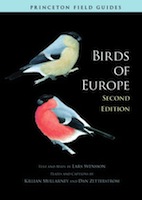When it comes to reviewing field guides, a reviewer can work his or way through a more or less generic checklist of items deemed important and evaluate: clarity of maps, detail of illustrations, helpfulness of descriptions, etc. From this, one can arrive at a reasonably reliable assessment of the book’s worth as a guide. However to determine the true value of such a guide, there is no substitute for “putting it through its paces” in the field – such as this reviewer recently had the remarkable privilege of doing during a trip across northern Europe that spanned from England to Russia. As a result, it can be confidently reported that the new (second) edition of the Birds of Europe is a must have guide for anyone interested in the birdlife of this geographic area.
 The guide covers the 713 species of breeding or regularly occurring birds in Europe, North Africa north of 30 degrees north latitude, Israel, Palestine, Jordan, Syria, Turkey, Armenia, Georgia, and Azerbaijan, plus the Canary Islands, Madiera, and the Sinai peninsula. In addition to these, it also includes the 59 occasional visitors, 32 escaped or introduced species now breeding somewhere in the area, and 118 very rare vagrants from other continents.
The guide covers the 713 species of breeding or regularly occurring birds in Europe, North Africa north of 30 degrees north latitude, Israel, Palestine, Jordan, Syria, Turkey, Armenia, Georgia, and Azerbaijan, plus the Canary Islands, Madiera, and the Sinai peninsula. In addition to these, it also includes the 59 occasional visitors, 32 escaped or introduced species now breeding somewhere in the area, and 118 very rare vagrants from other continents.
There is a strong emphasis on species occurring in Great Britain and Ireland, particularly demonstrated by the inclusion of an extensive coded notation to help those birding in these areas quickly to determine if a particular species has ever been recorded in those geographic areas. While at first perhaps a bit off-putting to those birding in the rest of the guide’s defined region (“what are we, chopped liver?”), a quick consideration of the fact that 1/3 of the first edition of the guide’s 700,000 total printed copies were sold in these two areas, despite it also having been translated into 13 different languages, puts this into perspective.
As there are multiple (and sometimes conflicting) international taxonomies for the birds in the region covered by this guide, the taxonomy employed in the guide is described as being organized around the “authors preference,” which is very similar to the IOC list (Gill and Wright, 2006) and follows the naming conventions accordingly.
So how does it fare in the field? Remarkably well. Extensively illustrated with meticulously painted images (no photographs appear in the guide whatsoever – something not at all troublesome to this reviewer, however others may be less than pleased), not just in profile but often in action poses as well, the guide provides a quick visual reference even to those entirely new to the birds of the region.
Naturally, not every identification challenge can be solved through visual cues alone, and it is in the textual descriptions that Birds of Europe gains particular merit. From the observation that the Thrush Nightingale is the “less satisfying” nightingale of northern and eastern Europe to the explanation of the Black Redstart’s habit of not only inhabiting rocky hillsides but industrial areas as well where it finds a synthetic home amid bricks and other construction materials (an invaluable piece of information for this reviewer whose first one was spotted in an industrial port in Copenhagen).
These and thousands of other seemingly insignificant bits of information are the stuff of true greatness in a field guide; they can only be written by authors exceptionally familiar not only with the birds discussed but with the needs of those who will be employing the book either in the field or for reference at a desk. Going bird watching in Europe without a copy of this new Birds of Europe would be at best fool-hardy; at worst, pointless.
Additional notes:
Birds of Europe, Second Edition, is published simultaneously in Great Britain and continental Europe as the Collins Bird Guide, Second Edition and as such is available both in jacketed hardcover as well as trade paperback editions.
 Book Title: Birds of Europe, Second Edition
Book Title: Birds of Europe, Second Edition
Author: text and maps by Lars Svensson, illustrations and captions by Killian Mullarney and Dan Zetterström
Publisher: Princeton University Press
Series: Princeton Field Guides
Format: Trade Paperback
ISBN: 978-0-691-14392-7
Published: February 1, 2010
In accordance with Federal Trade Commission 16 CFR Part 255, it is disclosed that the copy of the book read in order to produce this review was provided gratis to the reviewer by the publisher.

